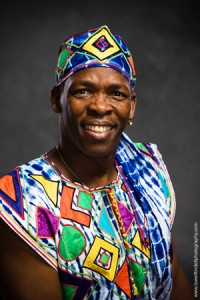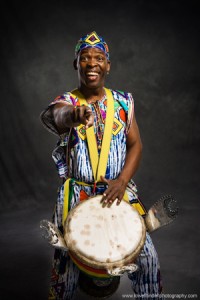 Mamady Keita was born in 1950 in Balandugu, a small village in Guinea, West Africa, near the border of Mali. Even before his birth his mother was told that his name would travel beyond Balandugu, beyond Guinea and beyond all of Africa. She did not know what that meant until Mamady was born and before he could even walk he would turn over anything that looked like a bowl and he would start hitting it like a drum. It was from that point on that his parents knew he was destined to be a djembe player and gave him the nickname nankama, born for it, and brought him to study with the Master Drummer of his village, Karinkadjan Kondé.
Mamady Keita was born in 1950 in Balandugu, a small village in Guinea, West Africa, near the border of Mali. Even before his birth his mother was told that his name would travel beyond Balandugu, beyond Guinea and beyond all of Africa. She did not know what that meant until Mamady was born and before he could even walk he would turn over anything that looked like a bowl and he would start hitting it like a drum. It was from that point on that his parents knew he was destined to be a djembe player and gave him the nickname nankama, born for it, and brought him to study with the Master Drummer of his village, Karinkadjan Kondé.
In 1957, Mamady was initiated into the secrets of the djembe and to the history of his people, the Mandingue. In 1963, he was taken to perform in the regional ballet, about 150 km from his home and in 1964, he was taken 2000 km away to the capital city Conakry where the President of Guinea, Sekou Toure was working with Harry Belafonte to produce the National Ballet of Guinea, Ballet National Djoliba. He was one of 50 percussionists who auditioned during 9 months of training and in the end was one of the final 5 who made it into the Ballet. At only 14 years of age, Mamady was by far the youngest member of the National Ballet. That same year he starred in the Harry Belafonte film, Africa Dance.
Mamady remained in the National Ballet until 1986, during which time he won gold medals in many International and Pan-African Festivals and was also named Best African Drummer. He went on to become the djembe soloist and lead drummer of Ballet Djoliba and in 1979 was named as Artistic Director. He created many of the musical repertoires used in the Ballets and trained many of the worlds top djembe players.
In 1986, Mamady decided to make his personal mark in the world by breaking out of the Ballet and establishing himself as an independent drummer. He moved to the Ivory Coast where he joined Souleymane Kolis group Koteba and performed next to such renowned African stars as Toure‚ Kunda of Senegal, and Mory Kante of Guinea. During his stay in Ivory Coast, Mamady starred in another movie, titled La Vie Platine, and also wrote and recorded the entire sound track.
When Mamady’s name began to travel beyond West Africa, a group of percussionists in Belgium decided to bring him into Europe to teach and perform. That happened in 1988 with a non-profit organization called Zig-Zag. In cooperation, Mamady helped open a school of percussion which they called Repercussions, and later that same year, Mamady established his own performance ensemble, Sewa Kan. The name refers to a Malinke proverb which says Without music there is no joy, but without joy there is no music.
 In 1991, Mamady decided it was time to go his own way and he established his own percussion school which he called Tam Tam Mandingue, drums of the Manding. Over the past 20 years the Tam Tam Mandingue network has grown to include 15 schools in North America, Europe, Australia, and Asia all dedicated fostering interest and participation in traditional West African drumming, dance, and cultural art forms, as well as to preserving and transmiting Mandingue musical tradition as a tool to promote tolerance, understanding, equality, and international peace.
In 1991, Mamady decided it was time to go his own way and he established his own percussion school which he called Tam Tam Mandingue, drums of the Manding. Over the past 20 years the Tam Tam Mandingue network has grown to include 15 schools in North America, Europe, Australia, and Asia all dedicated fostering interest and participation in traditional West African drumming, dance, and cultural art forms, as well as to preserving and transmiting Mandingue musical tradition as a tool to promote tolerance, understanding, equality, and international peace.
Mamady has produced 11 cds, 8 instructional video/DVDs, several documentary films (including internationally acclaimed Djembefola, by Laurent Chevalier), and the book, Mamady Keita: A Life For the Djembe. Co-written with Uschi Billimeier, the book is not only practical, with 60 rhythms notated and an instructional CD with 21 rhythms included, but it also gives historical and cultural information on the instruments and the rhythms themselves. Today, it is regarded as the best reference on the djembe and traditional rhythms; it is on its fifth edition and available now in 4 languages. A second book of rhythms, both traditional and original creations of Mamady’s is due out at the end of 2012.
 Amy Jackson 404.784.2462
Amy Jackson 404.784.2462